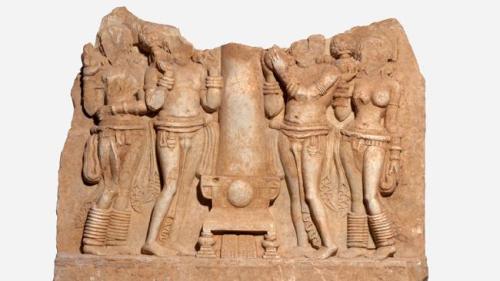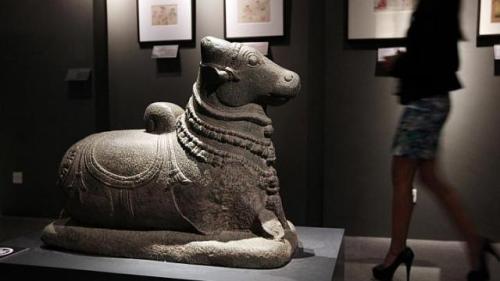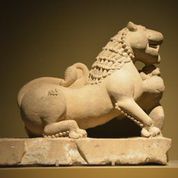
On Monday, the National Gallery of Australia returned three more antiquities to India in light of evidence – much of it first made public here – that they had been stolen from temples or archaeological sites, smuggled out of India and sold with false ownership histories by dealers now under criminal investigation.
In a ceremony in the Canberra museum’s Asian Gallery, the Australian Arts Minister Mitch Fifield handed over to his Indian counterpart Mahesh Sharma two sculptures purchased from the disgraced Manhattan antiquities dealer Subhash Kapoor, who is currently standing trial in Chennai, India for his role as the alleged mastermind of an international smuggling ring.
A third sculpture, a Kushan-era sculpture of the Seated Buddha purchased from Manhattan antiquities dealer Nancy Wiener and once a centerpiece of the Australian collection, is being quietly returned out of the public eye. We first revealed the sculpture’s false ownership history in February 2015 and wrote about it in The Australian with arts reporter Michaela Boland.
The three sculptures join the museum’s Dancing Shiva, an Ardhanarishvara from the Art Gallery of New South Wales and other objects returned in recent years, the results of a looting controversy that has shaken Australia’s museums and raised far-reaching questions about their collecting practices. Some 280 additional antiquities at the NGA alone have been identified as having a clouded ownership history by an unprecedented provenance review that is on-going.
The Australian returns underscore the growing risks faced by museums and collectors who purchased Asian antiquities in recent decades from what they believed to be respectable dealers and auction houses. As we’ve chronicled here since 2012, on-going criminal investigations by authorities in the United States, India, Pakistan, Cambodia, Thailand and beyond have slowly unraveled the transnational smuggling networks that supplied those dealers.
Sources hint that the sweeping consequences of those investigations will soon become far clearer. Monday’s Australian returns, therefore, are best understood as the end of the beginning phase of those investigations, not the end.
Kushan Buddha
 The Kushan sculpture of a Seated Buddha was likely returned out of the public eye on Monday because it no longer belongs to the museum. In March 2015, the museum announced that it had returned it for a refund to Nancy Wiener, the New York owner of the Wiener Gallery who sold the statue in 2007 for $1.08 million. Wiener, in turn, agreed to “donate” it to India.
The Kushan sculpture of a Seated Buddha was likely returned out of the public eye on Monday because it no longer belongs to the museum. In March 2015, the museum announced that it had returned it for a refund to Nancy Wiener, the New York owner of the Wiener Gallery who sold the statue in 2007 for $1.08 million. Wiener, in turn, agreed to “donate” it to India.

At the time of the sale, Wiener said the sculpture had belonged to an Englishman named Ian Donaldson, who claimed to have purchased it while posted in Hong Kong between 1964 and 1966. She provided the museum with a 1985 Certificate of Ownership signed by Donaldson. It was the only record of sculpture’s ownership history, but the museum did not attempt to contact Donaldson. Instead, the NGA obtained a search certificate from the Art Loss Register saying the sculpture was not in its database of stolen objects. As we’ve noted in the past, such declarations are largely useless for antiquities, yet that was the extent of the due diligence the museum conducted.
I first raised questions about the Buddha in 2012, after a source contacted me suggesting the statue’s ownership history had been falsified. The NGA eventually released documents supporting that claim and belatedly contacted the expert who had first authenticated the sculpture, Donald Stadtner. Stadtner raised further questions about the sculpture’s origins, claiming in an email to museum officials that British collector Douglas Latchford had boasted in a meeting that he had “found Nancy a provenance” for a related Kushan Buddha that Wiener sold to Singapore’s Asian Civilizations Museum. Through his attorneys, Latchford has denied ever meeting Stadtner.
The return of the NGA’s Seated Buddha will put increased pressure others to reveal the ownership history of similar objects. Singapore’s Asian Civilizations Museum has refused to disclose the provenance that Wiener provided for a very similar sculpture of a Seated Buddha.

Wiener has displayed images of a third Kushan Buddha on her gallery’s website. The current location of that Buddha is not known. Wiener has not responded to repeated requests for comment in the past.

Another similar Buddha is on display at the Carlos Museum at Emory University. That Seated Buddha was acquired as a gift of the Nathan Rubin-Ida Ladd Family Foundation, which is known to have acquired objects from Kapoor.

Kapoor Objects
The two other objects returned Monday are both from Subhash Kapoor and were linked to objects stolen from Indian temples by researcher Vijay Kumar of the Indian Pride Project.
In 2005, Kapoor sold both objects to the NGA for $1.5 million. One was an 1800-year-old limestone carving depicting a scene from the life of Buddha.

Kapoor told the museum the sculpture of the Buddha’s life had been in a private Japanese collection until 1999. But in July, we published this photo of the showing the unrestored sculpture as it appears in Kapoor’s archives, soon after it was stolen by thieves:

The second Kapoor object due to be returned in the ceremony Monday was a 1000-year-old stone goddess Pratyangira, or Lion Lady. Kapoor claimed the sculpture had been in the collection of his onetime girlfriend Selina Mohamed since 1990. But as we first reported in July 2016, photos and records found in Kapoor’s files show the Pratyangira was in Mumbai, India in 2002.
Kumar has linked the object to Vriddhachlam, the same temple that the Art Gallery of New South Wales Shiva was taken from.


Investigators believe Kapoor obtained the two objects from a Chennai art dealer named Deena Dayalan, who has operated an art gallery there since 1965 and is suspected of being a major player in the theft and smuggling of antiquities from the region. Indian authorities raided Dayalan’s properties in July and seized substantial evidence that may have led to Monday’s returns.



 The police raids have now spread beyond Tamil Nadu are likely to continue in the coming weeks that authorities unravel the smuggling network and sort through voluminous evidence. Authorities have identified the
The police raids have now spread beyond Tamil Nadu are likely to continue in the coming weeks that authorities unravel the smuggling network and sort through voluminous evidence. Authorities have identified the  Investigators are still looking for links between Dayalan and one of his prominent American clients: Subhash Kapoor, the Manhattan antiquities dealer now standing trial in India for selling stolen antiquities to museums around the world. “We have not got clinching evidence to prove [his] link with the international idol smuggler Subhash Kapoor,” one investigator
Investigators are still looking for links between Dayalan and one of his prominent American clients: Subhash Kapoor, the Manhattan antiquities dealer now standing trial in India for selling stolen antiquities to museums around the world. “We have not got clinching evidence to prove [his] link with the international idol smuggler Subhash Kapoor,” one investigator 
 But authorities have already identified Dayalan as the source of one stolen Kapoor object that has already been returned to India: The Art Gallery of New South Wales‘ sculpture of Ardhanarishvara, whose origins we
But authorities have already identified Dayalan as the source of one stolen Kapoor object that has already been returned to India: The Art Gallery of New South Wales‘ sculpture of Ardhanarishvara, whose origins we 




 On Monday, Immigration and Customs Enforcement agents recovered a Chola period bronze from Ball State University’s Owsley Museum, marking yet another trail in the path of stolen Indian artifacts sold by dealer Subhash Kapoor.
On Monday, Immigration and Customs Enforcement agents recovered a Chola period bronze from Ball State University’s Owsley Museum, marking yet another trail in the path of stolen Indian artifacts sold by dealer Subhash Kapoor.






 Last December we
Last December we 









 When The Hindu informed local authorities about the theft, the case was immediately referred to the
When The Hindu informed local authorities about the theft, the case was immediately referred to the 
